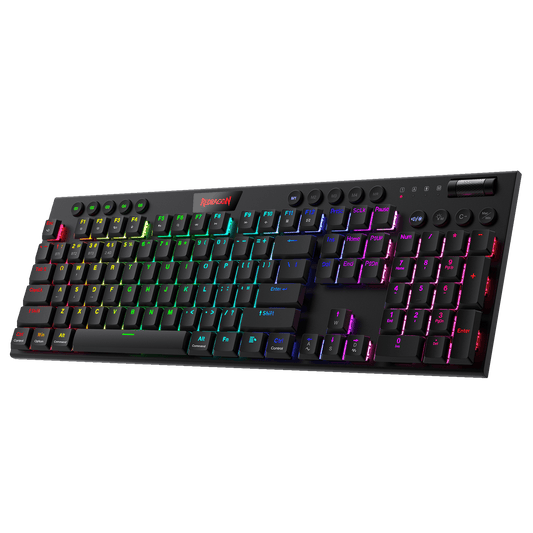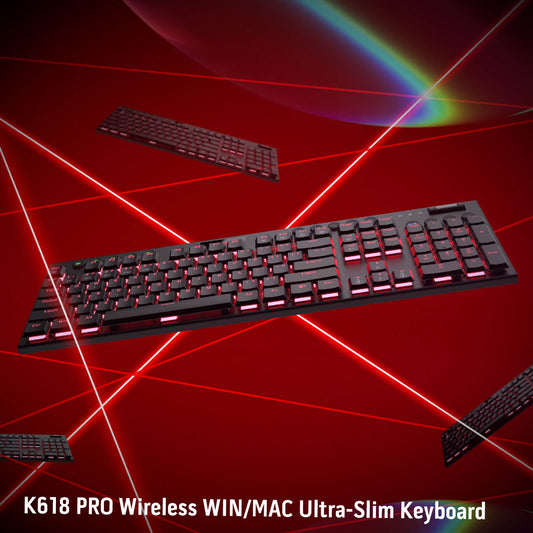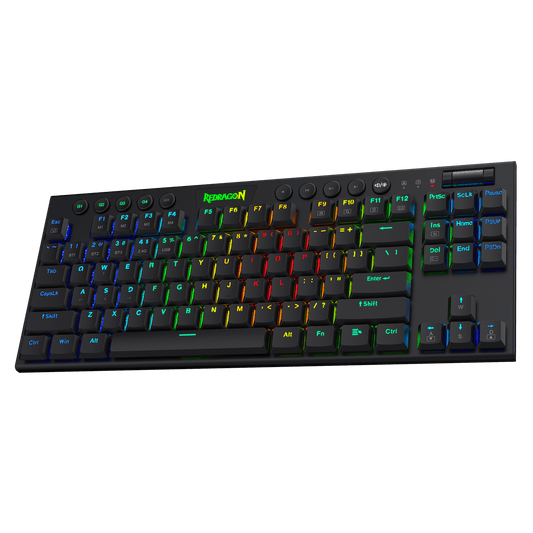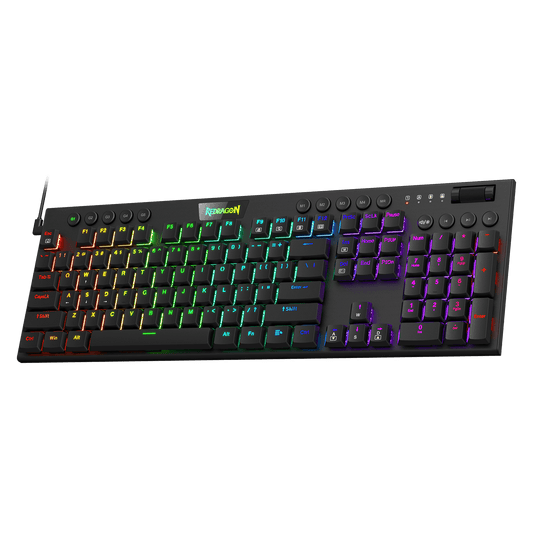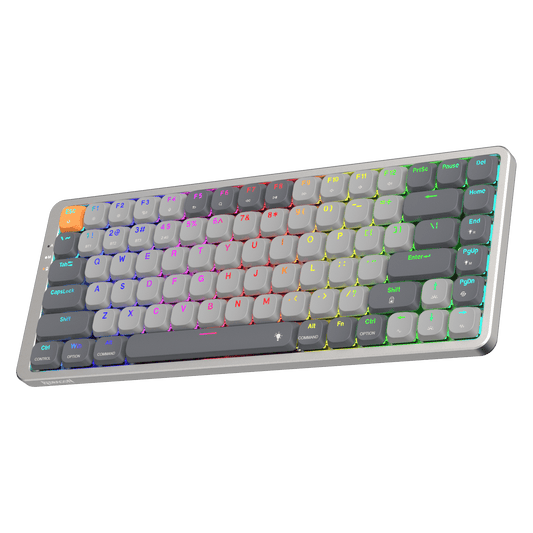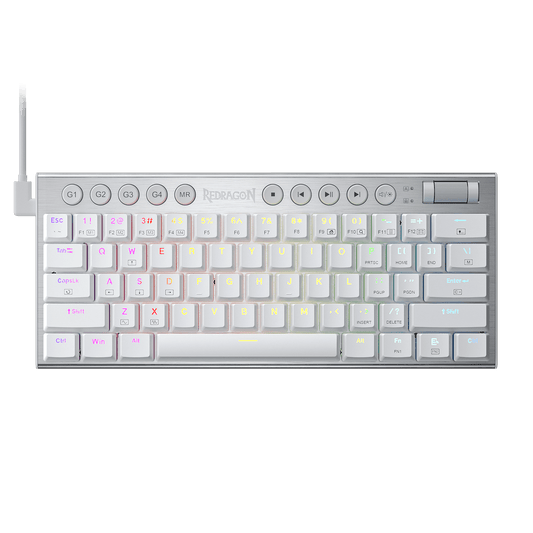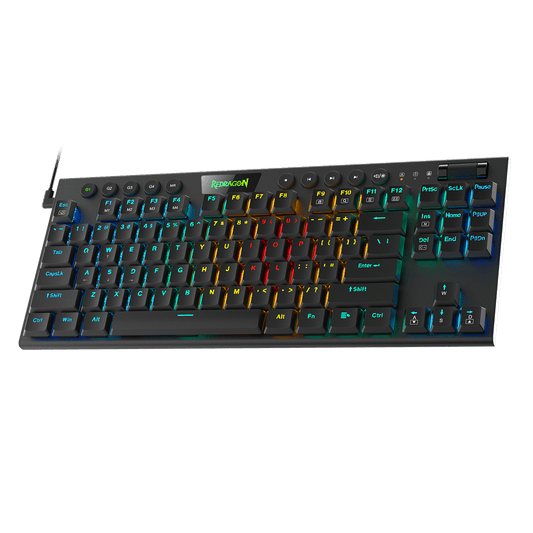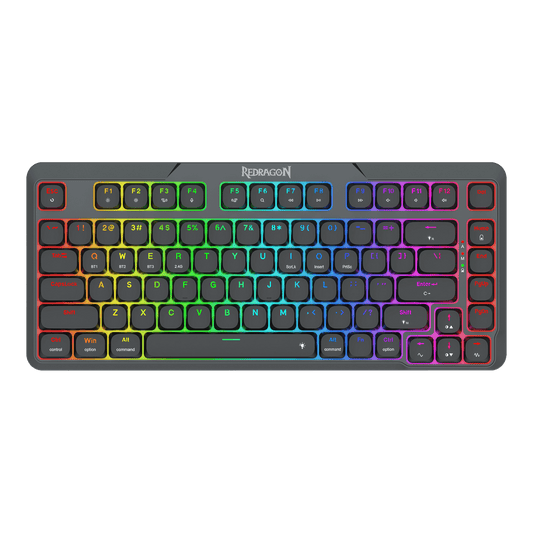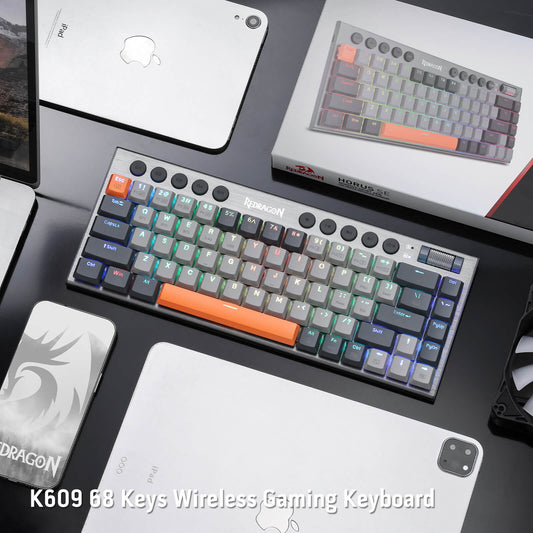Introduction
Low-profile keyboards are becoming increasingly popular among computer users, especially those who type for extended periods of time. These keyboards are designed to provide a comfortable and efficient typing experience while also being more compact and aesthetically pleasing than traditional keyboards.

In this review, we will be taking a closer look at low-profile keyboards and exploring the various features and benefits they offer. From their slim design to their tactile feedback, we will examine how low-profile keyboards can improve your typing experience and enhance your overall productivity. Whether you're a gamer, a writer, or simply someone who spends a lot of time on their computer, this review will help you determine if a low-profile keyboard is right for you.
Table of Contents:
What is a Low-Profile Keyboard?

A low-profile keyboard is a type of keyboard that has a thinner and flatter profile than a traditional keyboard. This means that the keys sit closer to the surface of the keyboard, resulting in a sleeker, more streamlined design.
Low-profile keyboards typically have scissor-switch mechanisms or membrane switches that require less travel distance and actuation force to register a keystroke. This design reduces the strain on your fingers and wrists, making it a more comfortable typing experience for extended periods.

Low-profile keyboards can be wireless or wired and are commonly used in laptops, tablets, and other mobile devices, as well as in desktop computers. They are also popular among gamers, as they offer faster and more responsive typing, making it easier to execute complex commands quickly.
Low-Profile Mechanical Keyboards Vs Standard Mechanical Keyboards

Low-profile mechanical keyboards and standard mechanical keyboards have a few key differences.
Profile
The first and most obvious difference is their profile. Low-profile mechanical keyboards have a thinner and flatter design than standard mechanical keyboards, with keys that sit closer to the surface of the keyboard. This design reduces the amount of travel distance required for key presses, resulting in a faster and more responsive typing experience.

Type of Switches
Another difference is the type of switches used. Low-profile mechanical keyboards typically use low-profile mechanical switches that have a shallower actuation point than standard mechanical switches. This means that less force is required to register a keypress, resulting in a smoother and more comfortable typing experience.
Standard mechanical keyboards, on the other hand, have a higher profile with keys that sit farther apart from each other. They usually use standard mechanical switches that require more force to register a keypress, resulting in a more tactile and responsive typing experience.

Ergonomics
In terms of ergonomics, low-profile mechanical keyboards are generally more comfortable to use for extended periods of typing due to their shallower key travel distance and reduced actuation force. However, standard mechanical keyboards are better for users who prefer a more tactile typing experience and don't mind the higher key travel distance and actuation force.
Overall, the choice between a low-profile mechanical keyboard and a standard mechanical keyboard comes down to personal preference and the intended use case.

Choose the keyboard switch that’s right for you
Are low-profile keyboards better for gaming or typing?

Low-profile keyboards can be suitable for both gaming and typing, depending on the user's preference and needs.
For gaming, low-profile keyboards can offer a more responsive and faster typing experience due to their shorter key travel distance and lower actuation force. This can be beneficial for games that require quick and precise key presses, such as first-person shooters or real-time strategy games.
For typing, low-profile keyboards can provide a more comfortable and ergonomic typing experience due to their reduced strain on the fingers and wrists. This can be beneficial for users who type for extended periods of time, such as writers or office workers.
However, it's important to note that the best keyboard for gaming or typing ultimately depends on personal preference and needs. Some users may prefer the tactile feedback and larger keys of a standard mechanical keyboard, while others may prefer the slim and compact design of a low-profile keyboard. It's recommended to try out different types of keyboards before making a purchase to determine which one works best for your needs.
The Pros and Cons of a Low-Profile Keyboard
Pros of a Low-Profile Keyboard:
-
Comfort: Low-profile keyboards are designed to reduce the strain on your fingers and wrists, which can be beneficial for users who type for extended periods of time.
-
Ergonomics: The flatter design of low-profile keyboards can also promote a more neutral wrist position, which can help prevent injuries like carpal tunnel syndrome.
-
Portability: Low-profile keyboards are generally more compact and lightweight than traditional keyboards, making them easier to transport and use in different locations.
-
Aesthetics: Many users find the sleek and modern design of low-profile keyboards to be more visually appealing than traditional keyboards.
Cons of a Low-Profile Keyboard:
-
Tactile Feedback: Low-profile keyboards often have a shallower key travel distance and less tactile feedback than traditional keyboards, which can make it harder to tell when a key has been fully pressed.
-
Customizability: Some low-profile keyboards may not have as many customization options as traditional keyboards, such as programmable keys or RGB lighting.
-
Learning Curve: If you're used to typing on a traditional keyboard, it may take some time to adjust to the different feel and layout of a low-profile keyboard.
-
Availability: Low-profile keyboards may not be as widely available as traditional keyboards, which can make it harder to find the right one for your needs.
Overall, the choice between a low-profile keyboard and a traditional keyboard depends on personal preference and needs. Low-profile keyboards can offer a more comfortable and ergonomic typing experience, but they may also have some drawbacks like reduced tactile feedback and customization options. It's recommended to try out different types of keyboards before making a purchase to determine which one works best for you.
How do I choose the right low-profile keyboard for my needs?

Choosing the right low-profile keyboard for your needs can depend on a variety of factors, including your budget, intended use, and personal preferences. Here are some things to consider when selecting a low-profile keyboard:
-
Switch type: Low-profile keyboards can use different types of switches, such as scissor switches or mechanical switches. Mechanical switches generally provide a more tactile feel and better durability, but they can be louder and more expensive than scissor switches. Consider what type of switch you prefer based on your typing or gaming needs.
-
Design: Consider the design of the low-profile keyboard, including the layout, size, and shape. Do you prefer a smaller or larger keyboard? Do you want a numeric keypad or media keys? Make sure to choose a design that suits your needs and preferences.
-
Compatibility: Make sure the low-profile keyboard is compatible with your computer or device. Check the connection type (USB, Bluetooth, etc.) and any necessary software or drivers needed to operate the keyboard.
-
Features: Consider any additional features you may want in a low-profile keyboard, such as backlighting, programmable keys, or wrist rests.
-
Reviews: Read reviews and user feedback from other customers to get an idea of the performance and reliability of the keyboard.
Ultimately, the right low-profile keyboard for you will depend on your individual needs and preferences. It's recommended to try out different keyboards before making a purchase if possible to find the one that feels most comfortable and suitable for your intended use.
Do low-profile keyboards require less force to type compared to regular keyboards?

Low-profile keyboards generally require less force to type compared to regular keyboards, but it can depend on the specific model and type of switch used. Low-profile keyboards with scissor switches typically have shallower key travel and require less force to press down the keys, which can be beneficial for people who type for extended periods or have limited hand strength.
On the other hand, low-profile mechanical keyboards, which use mechanical switches, can vary in the amount of force required to press down the keys depending on the type of switch used. Some mechanical switches used in low-profile keyboards, such as the Cherry MX Low Profile switches, have a lower actuation force compared to traditional mechanical switches, making them easier to press down.
Overall, low-profile keyboards can be a good choice for people who want a more comfortable and efficient typing experience, but it's important to try out different models and types of switches to find the one that feels most comfortable for your individual needs.
The Best Low Profile Keyboards of Redragon
NOCTIS K632 PRO -60% Keyboards

The Redragon K632 PRO low-profile keyboard is a high-performance keyboard that boasts a range of advanced features. It comes equipped with innovative 1st-Gen 3-mode connection technology that includes USB-C wired, BT 3.0/5.0 & 2.4Ghz wireless modes, making it the ultimate tool for all your needs. The HOT-SWAP Low-Profile feature allows you to change the switches without any hassle, providing a smooth and stable experience. The keyboard is also designed to be lightweight and compact, making it a perfect fit for on-the-go use. With its 30% Cutted Ultra-Thin design and more extra practical features such as 4*4 on-the-fly macro keys and a dedicated function area for media control, this keyboard is a must-have for anyone who demands high-quality performance.
Horus K621/HORUS K622 - TKL Keyboards

With a wired TKL low-profile design, 4*5 on-the-fly macro keys, and dedicated media control, the Horus K622 keyboard is a great choice for users. It offers 20 preset backlight modes. The K621 keyboard, on the other hand, is the premium version of the K622 and comes with a detachable USB type-c cable, 2.4G receiver, and Bluetooth 5.0 connection. This allows for seamless connectivity with all devices on the market, and users can effortlessly toggle between different devices in the 3 modes available.
The 80% TKL Low-Profile keyboard design features a compact tenkeyless 87 keys in low-profile, providing more space for mouse movement and shorter actuation distance, resulting in a precise performance at half the height, while retaining a white simplicity style.
Horus K618/HORUS K619 - Full-size Keyboards

The Horus K618 and K619 are both low-profile mechanical gaming keyboards with keys that are only 4mm tall and have the same layouts. However, the K618 keyboard is the updated version of the K619, with a detachable USB type-c cable, 2.4G receiver, and Bluetooth 5.0 connection.
In terms of other features, both keyboards have anti-ghosting and full-key rollover, as well as programmable macros and multimedia keys. They also both use a USB interface and come with braided cables for durability. With 20 macro and media keys, it's easy to launch the software, adjust the volume, and switch songs. The standard keys can be remapped for maximum customization, and the keyboard has 16.8 million colors of backlighting for a personalized touch. It also has a long-lasting 1900 mAh lithium battery and a low battery indicator. This full-size keyboard is great for PC gamers and anyone who uses a desktop computer.
Dimension/size
Keyboard Weight
Switch Type
Keys
Connection
Extra G Keys
RGB Backlit
Software
Dimension/size
11.6×4.9 in
Keyboard Weight
0.42 kg
Switch Type
Red Switch (Low profile)
Keys
61
Connection
Wired/BT/2.4Ghz
Extra G Keys
4
RGB Backlit
✓
Software
✓
Dimension/size
14.0×5.8 in
Keyboard Weight
0.60 kg
Switch Type
Red Switch (Low profile)
Keys
87
Connection
Wired
Extra G Keys
4
RGB Backlit
✓
Software
✓
Dimension/size
14.0×5.8 in
Keyboard Weight
0.60 kg
Switch Type
Red Switch (Low profile)
Keys
87
Connection
Wired/BT/2.4Ghz
Extra G Keys
4
RGB Backlit
✓
Software
✓
Dimension/size
17.2×5.8 in
Keyboard Weight
0.72 kg
Switch Type
Red Switch (Low profile)
Keys
104
Connection
Wired/BT/2.4Ghz
Extra G Keys
5
RGB Backlit
✓
Software
✓
Dimension/size
17.2×5.8 in
Keyboard Weight
0.70 kg
Switch Type
Red Switch (Low profile)
Keys
104
Connection
Wired
Extra G Keys
5
RGB Backlit
✓
Software
✓
Conclusion
In conclusion, low-profile mechanical keyboards offer a unique combination of style, comfort, and performance for those who value a sleek design and a tactile typing experience. With their slim profile and innovative switch technology, low-profile keyboards can be a great option for gamers, professionals, and anyone who spends a lot of time typing on their computer.
Whether you're looking for a budget-friendly option or a high-end keyboard with all the bells and whistles, there are plenty of low-profile mechanical keyboards on the market to choose from. From the Logitech G915 to the Keychron K1, each keyboard offers its own set of features and advantages.
Ultimately, the best low-profile mechanical keyboard for you will depend on your personal preferences and needs. However, by considering factors like switch type, key layout, and backlighting, you can find a keyboard that meets your requirements and enhances your overall computing experience.




































